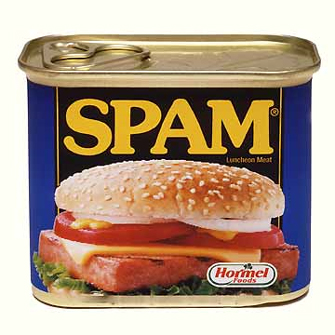Canned Spam. Yes, Please. I’ll take mine with a fried egg and toast.
No. No. Not the kind that you find on the grocery store shelves or hidden in the dark corner of your pantry.
CAN-SPAM is the law that all marketers (email marketers specifically) must follow or face some pretty hefty fines. We are talking upwards of $16,000 per email if you are caught red handed.
Yes, you read that correctly per email! Even with a list of TWO that would be a pretty big bill to pay.
Some parts of the law are pretty straight forward, but others are just down right mind boggling. In order to help you avoid these huge very costly mistakes, here are several ways that you could actually be breaking the law without knowing it.
1. There is No Way Out
This one I have seen personally more than once and every time it burns me up just a little more. It’s actually illegal to not have a clear way for your email recipients to easily unsubscribe. The only actual CAN-SPAM Compliance requirement is that it be easy for an “ordinary person to recognize and read” this information.
Most email marketers include this at the bottom of every outgoing email (as a footer). There normally is a clear button or link for you to unsubscribe from that particular list or newsletter.
You may have noticed recently that Gmail is making it easier for you and other readers alike to unsubscribe. They are now placing an unsubscribe link at the top of some emails. The idea is to make it simpler to remove yourself from unwanted promotional lists, to be able to opt out without having to sort through the fine print at the email’s footer. This feature was in test mode for some time, but recently Gmail has “turned it on” for everyone.
image source: Google
2. Keep Your List Tidy – Opt-out Who Has Asked
So you are a stickler for making it easy for people to opt out of your email communications, but you actually need to push the buttons to take them off. You know – follow through.
You have 10 days from the time they request to unsubscribe from your list to actually take them off of your list.
Most ESPs (email service providers – such as iContact or Aweber) give you a way to automate this entire process. OfferVault – Scoop subscribers for example have a two part process. There is a link located in the footer section of every email that leads to a Aweber page where they can choose to unsubscribe from just one or multiple lists at a time. Aweber then automatically opts them out from receiving any future emails based on their choices.
You are not allowed to charge a fee for removed from the list or require any information other than the user’s email address. The user can’t be required to do anything further than send you a reply email or visit a single (one – not two or three but ONE) webpage to unsubscribe.
One more note on this point, once a user has unsubscribed, you may not sell or rent that person’s information to anyone else.
3. Just Who Are You?
A huge no-no is pretending to be someone else, more specifically another website or company. This is often done to try and deceive or trick the recipient into opening your email or to avoid emails going to the junk or spam folder.
When sending emails to your list, you need to make certain that y ou and your business are clearly identified. Both the “From” email, and the reply-to addresses must be your own. The domain that you promote in your email must also either be your own or one that you are authorized to promote. The domain must also be what you say it is in your message. Example: it’s unlawful to tell people that you are going to a site that sells diet pills but redirect them to a dating site.
4. Misleading Subject Lines
This one is a touchy subject (no pun intended). The jest of this point is to live up to the promise in your subject line. If your subject line promises the reader a weekly discount on gas, then you need to actually come through with a weekly discount on gas. The law states that your subject lines can’t be “misleading.”
As you create your emails, think about ways that you can make it clear to your readers what you’re sending them. Try to put yourself in their shoes, as someone who may not be as familiar with your business and what you offer, and think of ways you can make sure they understand what you are sending them.
5. Is That an Ad?
Again don’t hide behind smoke screens or double mirrors. You must make it clear, either in small print at the top or bottom of your email, that the email is an advertisement. Also, be clear as to what the advertisement is for. For example, if your ad states that you will get $25 off but the fine print states that it’s $25 off AFTER a mail in rebate then that isn’t clear.
The ad below from Keurig clearly states that I would receive $6 off every 4 boxes of beverage packs and get a free K-Cup pack storage carousel if I ordered before 07/27/14.
6. Where in the World Are You?
This one is so very simple but seems to be overlooked time and time again. Somewhere in your email (traditionally at the bottom in the footer) you must provide your physical address (street or PO Box). No this does not have to be your personal home address. Most companies set up a PO Box or have a mail forwarding service. You just need to be able to receive communications via regular postal mail.
7. Monitor Your Email Agency
Monitor the heck out of your affiliates or marketing agency. It’s your name and livelihood on the line. You are legally responsible for the actions of anybody you hire or authorize to send marketing emails on your behalf. Both your company and the authorized person or company will be held responsible if any of the CAN-SPAM laws are not adhered to.
Below is a simple CAN-SPAM Checklist to keep you on the right side of the law:
1. You Have to Let People Know How to Opt-Out
2. When People Want Off Your Email List, Take Them Off.
3. Be Who You Say You Are!
4. Don’t Lie in the Subject Line
5. Tell Them That You’re an Advertisement
6. You Need to Have an Actual Physical Location
7. Make Sure You Know What Your Marketing Agency is Doing!
There you have it, follow these simple steps and you are well on your way to being CAN-SPAM compliant. Most ESPs will actually make sure that most of these criteria can be done automatically (such as footers with physical address, unsubscribe links, etc). However, it’s a good rule of thumb to review all of your marketing emails before they go out.
Disclaimer: I would like to emphasize that I am not a lawyer. This is in no-way should be considered legal guidance, and you should consult your own counsel for legal advice on how to interpret CAN-SPAM laws.




So true! So much we take for granted.